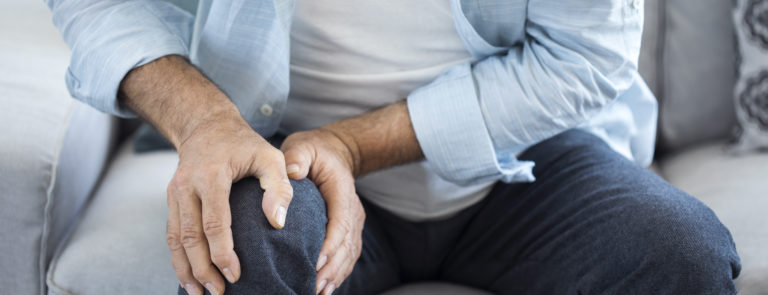Osteoarthritis is the most common type of
arthritis, affecting nearly 9 million people in the UK
1 . It causes the cartilage that surrounds the joint to thin and become rough.
What is osteoarthritis?
Commonly affecting the hands, spine, knees and hips, osteoarthritis affects the smooth cartilage lining of the joint. You may also see osteoarthritis referred to as OA.
Healthy cartilage is smooth and tough and allows joints to move freely against each other, however, once damaged, it becomes thinner and rougher making moving the affected joint more difficult than usual.
Once the cartilage starts to thin and become rough, this causes the tendons and ligaments, that also support joints to move, to work harder. This can cause swelling, pain and the formation of osteophytes.
Osteophytes are bony growths that the body creates on the affected joint to try and repair the damage made. Sometimes, the growths can rub against other tissues that surround the joint and may become visible on the surface of the skin.
In some cases, a large amount of cartilage loss can cause the joint to alter shape, forcing the bones out of their normal position.
Osteoarthritis symptoms
Pain and stiffness in joints are the main symptoms of osteoarthritis, commonly worsening as the joint is used more throughout the day.
Although osteoarthritis can affect any joint, the most common areas affected are the hands, fingertips, hips, knees, lower back and spine.
Visible symptoms like knobbly growths may also appear on affected joints.
You may also experience inflammation and swelling, due to the increased amount of synovial fluid. The fluid usually helps the joints to move without friction, but increased levels can cause swelling around the joint.
Severe symptoms can include the locking of joints, intense pain and decreased motion.
Osteoarthritis causes
Scientists haven’t been able to pinpoint what causes osteoarthritis, but they have identified that there are risk factors that could impact the likelihood of developing the condition
2.
Am I at risk of osteoarthritis?
Those that are over the age of 40, overweight, have experienced another
type of arthritis, have experienced a major injury to a joint or have had a joint operation all increase the risk of developing the condition.
Osteoarthritis is also more common in women and those that have a family member with the condition
3.
Osteoarthritis diagnosis
If you think you or a loved one is experiencing any of the above symptoms, you should talk to a medical professional and seek a diagnosis.
A diagnosis is based on; your symptoms and how and when they started, how they’ve developed, anything that makes them better or worse, and, how they are affecting your life.
A doctor will also conduct a physical examination and look for; restricted movement, tenderness, creaking of the joint (also known as crepitus), weakness or thinning of the muscles that support the joint, signs of osteophytes (bony growths) and excess fluid.
Your doctor may also conduct a blood test or an x-ray. This is usually to eliminate other types of arthritis, rather than to diagnose osteoarthritis and to identify is there is a fractured bone.
A doctor may recommend physical therapy or pain management help to support you if you’re symptoms are severe.
Osteoarthritis treatments
There’s no cure for osteoarthritis, but there are ways to manage your symptoms to help you continue to do the things you enjoy.
Natural remedies for osteoarthritis can include; managing your weight, physical activity like stretching and aerobic exercise or supplements can all help to manage the associated symptoms of osteoarthritis.
Pain management is also key to managing the condition. Pain medication may be prescribed by your doctor to help ease pain and any stiffness that you’ll experience.
Exercise for osteoarthritis
Keeping active is important throughout your life to strengthen muscles and improve your general fitness levels. It’s important to keep moving for at least 30 minutes a day as exercise is one of the best things you can do to help manage osteoarthritis symptoms
4.
If you’re experiencing pain and stiffness, you may think that exercising will make arthritis symptoms worse. However, exercises that build muscle and strengthen your joints can only improve symptoms
5.
Start slowly with gentle exercises that put less pressure on the joints. Walking on flat surfaces is a great, and free, way to keep active. Swimming is a great option to try as the water bears your weight yet acts as a resistance which helps to tone muscles.
If swimming isn’t your thing, try water aerobics. Most fitness and leisure centres now offer aqua aerobics on their timetables.
Stretching can help improve mobility and range of motion
6. Start by stretching as far as you can until you feel a stretch in the muscles. Hold this stretch for around 5 to 10 seconds and repeat 5 to 10 times.
Osteoarthritis vs rheumatoid arthritis
The difference between osteoarthritis and rheumatoid arthritis
may be hard to distinguish as both t
ypes of arthritis display similar symptoms, pain and stiffness of the joints.
However, osteoarthritis is a degenerative condition that worsens over time, whereas rheumatoid arthritis is an auto-immune disorder.
As above, osteoarthritis is the breakdown of cartilage that protects the joint which will eventually wear down completely.
Rheumatoid arthritis is where the immune system wrongly identifies cells that surround the joint as a threat, and destroys them, mush like it does when we have a virus.
Advice is for information only and should not replace medical care. Please check with your GP before trying any remedies.
Last updated: 11th February 2020
Sources
1
https://www.nhs.uk/conditions/arthritis/
2
https://www.versusarthritis.org/about-arthritis/conditions/osteoarthritis/
3
https://www.nhs.uk/conditions/osteoarthritis/
4
https://www.versusarthritis.org/about-arthritis/managing-symptoms/exercise/about-exercise/
5
https://www.nhs.uk/conditions/osteoarthritis/treatment/
6
https://www.healthline.com/health/osteoarthritis#exercises















